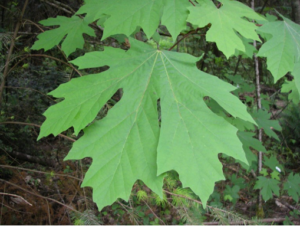Look up; look down. If it’s fall or winter, can you see golden yellow to brown leaves on the tree or on the ground? Hint: they are HUGE. If it’s spring, can you see buds of new leaves or flowers? If it’s summer, do you see giant green leaves and helicopter seeds hanging from the tree in bunches?
Big leaf maples are important riparian trees, providing shade for the creek and habitat for many critters. Squirrels, flying squirrels, rabbits, mice, woodrats, and birds eat its big seeds. Deer and beavers browse the leaves and young shoots, woodpeckers drill holes in the trunks in search of sap. Many birds use the maples for nesting and roosting, and numerous mammals, amphibians, and insects use them as their habitats. Native plants and animals have spent eons evolving and adapting with each other. You can help support wildlife by planting native plants that feed and shelter animals.

¿Puedes Encontrar un Maple De Hoja Grande?
Mira hacia arriba; mira hacia abajo. Si es otoño o invierno, podrás ver las hojas de color amarillo o café en los árboles o en el suelo. La pista es que son ENORMES. Si es primavera podrás ver capullos de hojas nuevas, o flores. Si es verano podras ver hojas grandes de color verde y sus semillas “helicoptero” colgando de las ramas.
Los maples de hoja grande son importantes árboles ribereños, proporcionan sombra para el arroyo y animales. Ardillas comunes y ardillas voladoras, conejos, ratones, ratas de bosque y aves, comen sus semillas. Venados y castores exploran las hojas y brotes. Los pájaros carpinteros hacen hoyos en el tronco para llegar a la savia del árbol. Muchos tipos de aves usan los maples para hacer sus nidos y también son el hábitat de muchos mamíferos, anfibios e insectos. Las plantas nativas y animales han evolucionado y se han adaptado unas a otras. Puedes ayudar a la vida silvestre plantando plantas nativas que alimentan y protegen a los animales.
